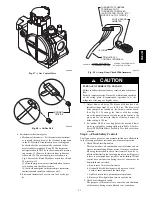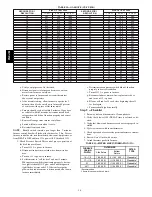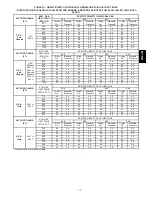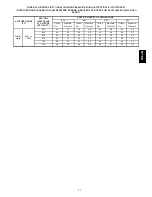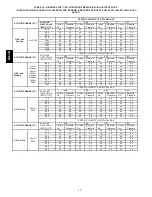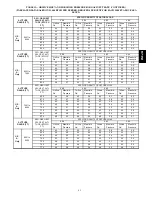
28
APPLIANCE APPLICATION REQUIREMENTS
Appliance operation has a significant impact on the performance
of the venting system. If the appliances are sized, installed,
adjusted, and operated properly, the venting system and/or the
appliances should not suffer from condensation and corrosion.
The venting system and all appliances shall be installed in
accordance with applicable listings, standards, and codes.
The furnace should be sized to provide 100 percent of the design
heating load requirement plus any margin that occurs because of
furnace model size capacity increments. Heating load estimates
can be made using approved methods available from Air
Conditioning Contractors of America (Manual J); American
Society of Heating, Refrigerating, and Air--Conditioning
Engineers; or other approved engineering methods. Excessive
oversizing of the furnace could cause the furnace and/or vent to
fail prematurely.
When a metal vent or metal liner is used, the vent must be in
good condition and be installed in accordance with the vent
manufacturer’s instructions.
To prevent condensation in the furnace and vent system, the
following precautions must be observed:
1. The return--air temperature must be at least 60
_
F db except
for brief periods of time during warm--up from setback at
no lower than 55
_
F db or during initial start--up from a
standby condition.
2. Adjust the gas input rate per the installation instructions.
Low gas input rate causes low vent gas temperatures, caus-
ing condensation and corrosion in the furnace and/or vent-
ing system. Derating is permitted only for altitudes above
2000 ft.
3. Adjust the air temperature rise to the midpoint of the rise
range or slightly above. Low air temperature rise can cause
low vent gas temperature and potential for condensation
problems.
4. Set thermostat heat anticipator or cycle rate to reduce short
cycling.
EXTERIOR MASONRY CHIMNEY FAN + NAT
INSTALLATIONS WITH TYPE--B DOUBLE--WALL
VENT CONNECTORS
TABLE A–COMBINED APPLIANCE MAXIMUM INPUT
RATING IN THOUSANDS OF BTUH PER HOUR
VENT
HEIGHT
(FT.)
INTERNAL AREA OF CHIMNEY
(SQ. IN.)
12
19
28
38
6
74
119
178
257
8
80
130
193
279
10
84
138
207
299
15
NR
152
233
334
20
NR
NR
250
368
30
NR
NR
NR
404
TABLE B–MINIMUM ALLOWABLE INPUT RATING OF
SPACE--HEATING APPLIANCE IN THOUSANDS OF
BUT PER HOUR
VENT
HEIGHT
(FT.)
INTERNAL AREA OF CHIMNEY
(SQ. IN.)
12
19
28
38
Local 99% Winter Design
Temperature: 17 to 26 degrees F*
6
0
55
99
141
8
52
74
111
154
10
NR
90
125
169
15
NR
NR
167
212
20
NR
NR
212
258
30
NR
NR
NR
362
Local 99% Winter Design
Temperature: 5 to 16 degrees F*
6
NR
78
121
166
8
NR
794
135
182
10
NR
111
149
198
15
NR
NR
193
247
20
NR
NR
NR
293
30
NR
NR
NR
377
Local 99% Winter Design
Temperature: ---10 to 4 degrees F*
6
NR
NR
145
196
8
NR
NR
159
213
10
NR
NR
175
231
15
NR
NR
NR
283
20
NR
NR
NR
333
30
NR
NR
NR
NR
Local 99% Winter Design
Temperature: ---11 degrees F or lower
*
Not recommended for any vent configuration
* The 99% Winter Design Dry---Bulb (db) temperatures are found in the
1993 ASHRAE Fundamentals Handbook, chapter 24 , Table 1 (United
States) and 2 (Canada), or use the 99.6% heating db temperatures
found in the 1997 or 2001 ASHRAE Fundamentals Handbook, Climatic
Design Information chapter, Table 1A (United States) and 2A (Canada).
PG
8J
/M
Содержание PG8J
Страница 36: ...36 A08411 Fig 46 Wiring Diagram PG8J M ...
























